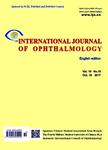Changes in ocular surface status and dry eye symptoms following femtosecond laser-assisted cataract surgery
Changes in ocular surface status and dry eye symptoms following femtosecond laser-assisted cataract surgery作者机构:Guangzhou Aier Eye Hospital
出 版 物:《International Journal of Ophthalmology(English edition)》 (国际眼科杂志(英文版))
年 卷 期:2019年第12卷第7期
页 面:1122-1126页
核心收录:
学科分类:10[医学]
基 金:Supported by Medical Science and Technology Research Foundation Project of Guangdong Province(No.C2017029) Science and Technology Project of Yuexiu District,Guangzhou(No.2017-WS-013)
主 题:ocular surface dry eye tear film femtosecond laser-assisted cataract surgery
摘 要:AIM: To observe the changes in ocular surface and the dry eye symptoms following femtosecond laser-assisted cataract surgery(FLACS). METHODS: Patients with no eye signs or symptoms in Guangzhou Aier Eye Hospital between October 2017 and September 2018, who underwent FLACS and intraocular lens(IOL) implantation for age-related cataract were enrolled. Tear film stability assessed with OCULUS Keratograph 5 M, Schirmer’s I test(SIT), and corneal fluorescein staining(CFS) were evaluated before and after surgery at 1 d, 1 wk, 1, and 3 mo in order. Ocular Surface Disease Index scores(OSDI) and Subjective Symptom Questionnaires(SSQs) were recorded at the same time ***: Thirty-eight eyes of 38 patients were enrolled. The noninvasive tear film break-up time(first break-up time and average break-up time) decreased in a peak at the 1 wk visit, and then increased to basic levels at 1 mo. The tear meniscus height(TMH) increased transiently at 1 d, and declined in the following 3 mo visits. The SIT had a transient increase at 1 d(P=0.357) and a decrease at 1 wk and 1 mo(both P0.05) but returned to the preoperative levels at 3 mo after surgery(P=0.062). CFS scores were significantly improved compared with those before surgery, and had a statistical difference(P0.05). OSDI scores and SSQs after surgery were obviously higher, and had a statistical difference(P0.001) but didn’t return to the basic level by 3 mo. CONCLUSION: Dry eye signs and symptoms can occur immediately following FLACS and have a peak severity on day 7 postoperatively. Most signs of dry eye can return to preoperative basic levels within 3 mo postoperatively. However, all cases can not recover from CFS and dry eye symptoms at 3 mo postoperatively.



